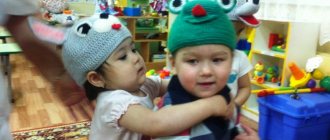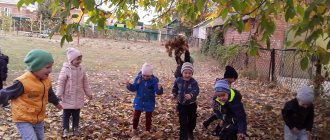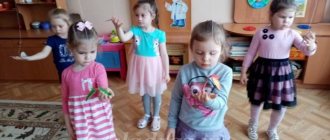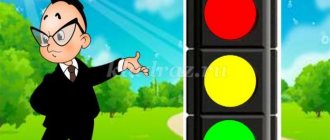Card index of summer walks in the 1st junior group
SUMMERCARD 2
1.
Observation of weather conditions.
Target.
Check with the children the weather conditions: fine day, hot, warm, warm breeze blowing.
2.
Game exercise: “Jump to your palm.”
Target.
Teach children to jump high on two legs.
3.
Role-playing game : “ Family ”
Goal.
Promote children’s desire to independently select toys and attributes for play, and use substitute items.
4.
D/i: “Find and name”
Purpose.
Develop the ability, following the teacher’s verbal instructions, to find objects and name them, their color, size, shape.
5.
P/n : “ Through the stream .
” Target.
Strengthen children's ability to walk on an inclined board while maintaining balance.
6.
Drawing in the sand with your finger.
"Sun". Target.
Develop children's imagination, strengthen the ability to draw rounded shapes.
7.
Independent motor activity.
Target.
To instill in children a desire to perform physical exercises. walking exercises.
SUMMER
CARD 4
1.
Observation of insects.
Target.
Learn to name: butterfly, beetle, ladybug, behave calmly near insects without harming them.
2.
D/i: “Like a beetle buzzes.”
Target.
Develop auditory perception, develop the articulatory apparatus.
3.
Game exercise: “Jump over the cord.”
Target.
Practice jumping over obstacles.
4.
Labor assignment: rake sand into a pile and transfer it to the sandbox.
Target.
Involve children in performing simple labor actions.
5.
P/n: “Sunshine and rain.”
Target.
Teach children to walk and run in all directions, without bumping into each other, to teach them to act on the teacher’s signal.
6. Telling a nursery rhyme: “Shadows - shadow, shadows...”,
with performing game actions.
Target.
Accompany the reading of a short poetic work with playful activities.
S/d game: “Let’s teach Katya to use a handkerchief.”
Target
. Develop skills in using ind. objects.
SUMMER
CARD 6
1.
Observing the weather.
Target.
Teach children, together with the teacher, to note the state of the weather
/
the sun is shining and it is raining, which passes quickly.
White, light clouds float across the sky .
2.
Game exercise: “Hit the target.”
Target.
Teach children to throw a ball at a target.
3.
Labor assignment:
collect toys in a basket at the end of the walk.
Target.
Teach children to perform simple work tasks.
4.
Individual work on physical education: “Bunnies”.
Target.
Practice jumping on two legs.
5.
D/i: Who came to us.
Target.
Teach children to recognize and name animals, clearly pronouncing the sounds
[m], [b], [m'], [b'],
individual sound combinations, and imitate the voices of animals.
6.
P/n: “Sparrows and a car.”
Target.
To teach children to run in different directions without bumping into each other, to start moving and change it at the teacher’s signal, to find their place.
7.
Independent play activity.
Target.
Encourage children to play together in small groups.
SUMMER
CARD 8
1.
Observing plants blooming in a flower bed.
Target.
Teaches you to admire them, but not to tear them. Fix the names of the parts of the plant: stem, flower.
2.
Game exercise: “Jump into the water.”
Target.
Teaches children to jump off a bench, landing on both feet.
3.
Labor assignment on the site:
watering seedlings.
Target.
Help adults take care of plants.
4.
P/n: “ Airplanes ” .
Target.
Teach children to run in different directions without bumping into each other, and to act on a signal.
5.
D/i: “Moms and children.”
Target.
To consolidate knowledge about poultry and their young.
6.
Narration of the poem by Z. Alexandrova: “Dandelion.”
Target. Consider a dandelion. Introduce children to the beauty of the world around them.
7.
S/r game: “Family”.
Target. Teach children to play together. Develop skills in using ind. objects.
8.
Independent play activity.
Target.
Encourage children to play together in small groups.
SUMMER
CARD 10
1.
Observation of trees and shrubs.
Target:
teach children to distinguish trees and shrubs by appearance and leaf structure. To develop the ability to see the beautiful in life, to admire nature.
2.
Didactic task:
show where the plant’s stem / leaves, branches, flower /.
Target:
teach to distinguish parts of a plant, name their color.
3.
Individual work on PHYS.
Target:
Exercise children in walking on an inclined board and throwing at a distance from behind their heads. To cultivate courage and dexterity in children.
4. Work order:
Rake the sand into a pile and transfer it with a bucket to the sandbox.
Goal:
to teach children to carry out simple work tasks.
5.
P/n: “Carousel”. Purpose:
to teach children to run after each other at different paces, to perform actions in accordance with the text of the game.
6.
Round dance game: “Ah, birch tree, green, curly.”
Target:
develop a desire to listen to a folk song, sing along and perform simple dance movements.
7.
Playing with water and sand: “Catching toys floating in the water with a net.”
Target:
consolidate knowledge about the properties of objects/heavy ones sink, light ones float, a paper boat gets wet, a plastic boat gets wet...
8.
Independent play activity.
Target:
teach children to play together in small groups.
SUMMER
CARD 12
1.
Herringbone.
Target walk. Target:
show the children where it grows. Examine it, pay attention to the parts of the tree: trunk, branches, needles. Make sure the needles are prickly. Make a riddle about the Christmas tree.
2.
Individual work on physical education.
Purpose: to train children in walking on an inclined board. Develop balance.
3.
Labor assignment:
collecting twigs and pebbles in a bucket at the site.
Goal:
to instill in children basic work skills.
4.
P/n: “Bubble” Purpose:
to teach children to stand in a circle, to make it wider, then narrower, to teach them to coordinate their movements with the spoken words.
5.
D/i: “Pick up a window and a roof for the house.”
Goal: to teach children to distinguish sensory characteristics: color, shape, size.
6.
Music-did.
game: “The chicken went out for a walk...” Purpose:
teach to expressively convey the image or character of the game’s characters through movement and facial expressions. Enrich children's motor experience.
7.
Independent gaming room.
Goal: to teach children to play together in small groups.
SUMMER
CARD 14
1.
Observation of a rosehip bush.
Target:
teach children to notice the changes that have occurred with the bush / buds have opened, pink flowers have appeared /, as well as to highlight the characteristic features of rosehip / spiny/. Therefore, you can smell it, but you cannot touch or tear it.
2.
Individual work on physical education.
Goal: to train children in throwing and catching a ball, to develop coordination of movements.
3.
Labor assignment:
watering dry sand from watering cans.
Target:
consolidate knowledge about the properties of sand /dry - pours, wet - molds/.
4.
P/n: “Shaggy dog.”
Goal: to teach children to move in accordance with the text, quickly change the direction of movement, run, trying not to get caught by the catcher and without pushing.
5.
Playing with sand.
Goal: to consolidate the concepts of wet and dry. / Dry sand pours out, you can’t sculpt with it. Wet - easier to pile up, load, transport. You can build a garage or a road for cars from it.
6.
D/i: “Whose dandelion will fly further.”
Goal: to develop the ability to exhale air through the mouth for a long time and smoothly.
7.
Game exercise: “Jump into the water.”
Target:
teach children to jump off a bench, landing on both feet.
8.
Independent play activity.
Target:
teach children to independently select toys for play and use substitutes. Play together, share toys with peers.
SUMMER
CARD 16
1.
Transport surveillance.
Goal: to teach children to recognize and name vehicles on the street. Identify common features /steering wheel, cabin, headlights, wheels/.
2.
Work assignment:
sweep benches and tables.
Target:
involve children in performing basic labor activities.
3.
D/i: “What’s for what.”
Goal: to expand the experience of orientation in parts of one’s own body / head, face, arms, back, etc. /
4.
Game exercise: “ Catch the ball .
” Target:
learn to throw and catch the ball with both hands.
5.
P/n: “Hen and chickens.”
Target:
teach children to crawl under the rope without touching it, and to be careful. Teach to act on a signal, not to push other children, to help them.
6.
Playing with water: “Fun fishing”.
Goal: to consolidate the ability to use a fishing rod, develop an eye, quick reactions, and create a joyful mood.
7.
Drawing with crayons on the asphalt: “Rain.”
Target:
continue to teach children to draw broken vertical lines.
8.
Independent play activity.
Target:
teach children to play together in small groups, teach them to share toys, and not quarrel.
SUMMER
CARD 18
1.
Observation of the sun.
Target.
Form the idea that when the sun is shining, it’s warm outside. Maintain a joyful mood.
The sun looks through the window
He looks into our room.
We clapped our hands
We are very happy about the sun.
2.
Work order.
Collecting dry grass on the site. Target.
To instill in children a desire to work and enjoy the work they do.
3.
D/i: “Find a couple” Purpose.
Teach children to classify objects by color/shape/.
4.
P/n: “Cat and Mice” Goal.
Run without bumping into each other.
5.
P/n: “Get into the circle.”
Target. Improve your ability to operate with objects. Learn to hit the target, develop your eye and dexterity.
6.
Individual work on PHYS: “Gate”.
Target. Exercise children in crawling under an arch.
7.
Finger game: “The horned goat is coming...”
Target . Development of fine motor skills of the hands.
8.
Independent play activities with external material.
Target. Teach children to independently select attributes and substitute toys for games.
SUMMER
CARD 21
1.
Observation: pedestrian path - transport /evening/ Purpose.
To consolidate knowledge about the rules of behavior on the street, to develop attention and spatial orientation skills. Explain to children that they are pedestrians and must strictly follow traffic rules, move only on pedestrian paths / sidewalks /. Where should we go. How they should go. /Slowly, don’t shout, be attentive, listen to the teacher/. Who walks on the sidewalk. Is it possible to run on the sidewalk? Why.
Today I am a pedestrian. I have a leisurely pace.
There are no wheels and no steering wheel, There is earth under my feet.
I don't push anyone, I don't overtake anyone,
I'm going to kindergarten, They'll say: baby pedestrian
He's going to kindergarten right.
2.
Outdoor game: “Sparrows and a car.”
Target.
To teach children to run in different directions without bumping into each other, to start moving and change it at the teacher’s signal, to find their place.
3.
Choir game: “We are funny guys...” Goal.
Learn to run in a straight direction, to see someone running in front and next to you.
Develop the ability to navigate in space, coordinate your actions with the actions of other children. We are funny guys, We love to run and play,
Ball, try to catch us. One, two, three - catch up.
4.
Labor assignment: cleaning up sticks and pebbles on the site.
Goal: to teach to work together, to receive satisfaction from the work done.
5.
D/i: “It’s possible or not.”
Target. Continue to teach children the rules of safe behavior with dangerous objects.
6.
D/i: “Family”.
Target. Continue to consolidate children's knowledge about family members: names. Family relationships. Create a feeling of love and care.
7.
Individual work on physical education.
Exercise: “Catch the ball.” Goal: learn to catch and throw a ball with both hands.
8.
Independent play activity.
Goal: to teach children to group together in groups of two or three to play together.
SUMMER
CARD 22
Observation of the driver's work /day/
Target:
introduce the work of a driver. Foster a positive attitude towards adult work.
While walking, pay attention to the grocery car and invite everyone to come closer to it. Who drives the car? Meet the driver. What they brought to kindergarten. How to drive a car. After the story, walk around the car and examine it. The work of a driver is difficult and complex, but people everywhere need it.
P/i “Locomotive” Purpose:
learn to move at different tempos, change direction, convey the characteristic movements of birds and animals, and practice pronouncing sounds.
Sedentary game “On a narrow path”
Target:
learn to step from circle to circle /drawn in chalk on the asphalt/.
Work order: sweep sand from benches.
Target:
to accustom children to basic labor actions, to bring the work started to the end.
Individual work on PHYS. Exercise “Bunny” Purpose:
train children to jump on two legs and move forward.
D/i “What color do we have” Purpose:
teach children to name items of clothing and their color. Develop attention.
Playing with sand. Making pies and cookies using molds. Target:
show the properties of sand / you can make cookies from wet sand /.
Independent games with external material.
Goal:
to teach children to independently select attributes and substitute toys for games.
P/i “Sparrows and the car”
teach children to run in different directions without bumping into each other. Start moving and change it only at the teacher’s signal, find your place.
Imp “Along a narrow path...” Objective:
teach to walk on the cord calmly, slowly, without fear.
Job assignment: cleaning up trash on site. Target:
develop the ability to perform simple work actions. Foster a sense of responsibility.
P/n “My funny ringing ball”
teach children to jump on two legs, listen carefully to the text, and catch the ball only when the words are spoken.
Games with water: “Dives”. Target:
fix the properties of objects. /Show that small ping pong balls do not sink, but jump out of the water/.
Independent play activity with external material Purpose:
teach children to independently select attributes and substitute toys for games.
Goal: To develop the activity and curiosity of children of primary preschool age in the process of cognitive activity.
Educational:
form an idea of the properties of sand;
teach children the skills of experimenting with sand;
encourage children to independently find a solution to a problem and teach them to express their suggestions and judgments;
Educational:
develop fine motor skills of the hands;
enrich tactile experience:
develop speech activity, communication skills, attention and memory;
Educational:
evoke positive emotions associated with new experiences;
cultivate interest in artistic activities.
Integration of educational areas:
Speech development, cognitive development, artistic and aesthetic development.
Preliminary work:
Looking at autumn trees. Learning a song. Playing with sand.
Equipment:
A bag of sand, a plate of sand, leaf templates, PVA glue, colored sand.
Progress of the lesson:
Educator: Look, guests have come to us, they want to see how we will play with you. Let's say hello to them.
Educator: Children, take the bag in your hands. What color is the bag? Guess what's in the bag?
(Children's answers. Sand.)
Educator: Guys, sand is not only in bags but also in plates.
Educator: Guys, do you like to play with sand? (Answer.)
What color is the sand? (Answer.)
Tell me, what can you make from sand? (Answer.)
Guys, is it possible to sculpt from dry sand? (Answer.)
How can you play with dry sand? (Answer.)
Is it possible to paint with dry sand? (Answer.)
Educator: Guys, I want to invite you to paint with your fingers in plates with sand. (Children draw with their fingers: rain, paths and sun.)
Let's draw rain with you. (They draw rain.) Now let’s stroke the sand with a pen and draw paths.
Physical education minute
The sun is shining brightly (hands are lanterns)
And the guy invites (hands forward, bends)
Play sand now (simulates playing with sand)
Come out quickly, my friend (steps).
Educator: Guys, now come to the table and look at the magic sand I brought you. What color is the sand in this cup? (Answer.) What color is in this glass? We have leaves on the table, they are not beautiful, but let's decorate them. I take red sand and sprinkle it on the leaf. And now I will take the yellow sand and also decorate the leaf. Look what beautiful leaves I got. Now take the sand and decorate your leaves. Look how the magic sand decorated our leaves. I really want to sing a song about them.
Song: “Come Beauty.”
Educator: Guys, let's admire the beautiful leaves. How did we color them? What kind of sand? Was it dry or wet?
Organization and methodology of walks in the summer
Author: Kravyakova Svetlana Vitalievna
Consultation for educators “Organization and methods of conducting walks in the summer”
Good afternoon, dear colleagues!
Today we are starting with you our seminar - a workshop on organizing and conducting walks in the summer.
I would like to start my speech with the statement of one pediatrician who said: “A day spent by a child without a walk is lost for his health” (G.N. Speransky)
So what is a walk?
A walk is a routine moment of children’s life activity in a preschool institution, organized in advance by the teacher, which takes place in the fresh air.
You all know well that the daily routine of any kindergarten includes a daily afternoon walk after classes and an evening walk after afternoon tea. According to
According to sanitary and epidemiological rules and regulations, the total duration of the walk is 4 - 4.5 hours.
In the summer, the kindergarten daily routine provides for children to spend maximum time in the fresh air with breaks for meals and sleep.
The time allotted for walking must be strictly observed.
But, in fact, children walk less, the duration of the walk is reduced for various reasons, and its health-improving and developmental potential is far from being fully used. Disorganization and monotony are typical disadvantages of organizing walks in kindergarten. And the pedagogical influence on a walk is often replaced by childcare.
Therefore, in order to properly organize and manage children’s activities during a walk, the teacher must expand his knowledge, possess practical skills, as well as methods for conducting a walk.
And first, let's remember what kind of walks there are.
Types of walks:
- Traditional/typical – the most free activity for children.
- Combined – targeted walk and free activity. (Targeted walk is carried out from the second younger group with exit outside the kindergarten);
- Excursion (conducted from the middle group at least once a month);
· Hiking (with children of senior preschool age).
Today at the seminar we will look in detail at the structure and methodology of conducting a traditional/or standard walk.
Proper organization of such a walk involves the use of five parts:
· Observation;
· Labor activity of children;
· Outdoor games
· Individual work with children;
· Independent activity of children.
The effectiveness of all parts of the walk depends entirely on the teacher. These components allow you to make your walk more eventful and interesting. In addition, they act not as separate pedagogical events, but as logically substantiated parts of what is planned by the teacher in a specific outing.
And now, let's take a closer look at each component of the walk.
Observations can be roughly divided into several types:
• Observations of wildlife (representatives of flora and fauna - plants, animals, birds, insects).
• Observations of inanimate nature (seasonal and weather phenomena, familiarity with the properties of water, sand, clay, natural materials - stones, shells, etc.).
• Observations of the work of adults (observations of the work of adults who work near the kindergarten are organized: janitor, driver, builder, policeman).
• Observations of street life (public, personal transport, trucks, cars, special vehicles, colorful decorations for the holidays).
At a younger age, observations should take no more than 5-10 minutes, at an older age they should range from 10 to 20 minutes. They must be carried out daily, and each time children should be offered different objects to consider.
It is very difficult to hold the attention of a child, especially one of primary preschool age. While walking, a child encounters a lot of distractions: he noticed a flying butterfly or was distracted by the noise of a passing car, and there are a lot of such distractions on the street. Therefore, observations should not be extended in time, vivid, interesting and meaningful. When planning observations, the teacher must think about: the equipment and materials that he will use during the observation, the placement of children, the teacher must think about ways to attract the attention of children (this could be: surprise moments, the use of artistic words: poetic texts, riddles, proverbs and sayings, which are perceived by children with great interest and other techniques), it is also necessary to involve the children themselves in activating mental activity (and this can be done by asking search questions and using children’s experience). The main thing in this component of the walk is not to leave children indifferent to the sight of vivid images and events in the environment.
The next important component of the walk is outdoor games.
. This part of the walk includes: 2-3 games of high mobility, 2-3 games of low and medium mobility, games of the children’s choice and didactic games are also used.
Outdoor games in the junior group - 6-10 minutes, in the middle group - 10-15 minutes, in the senior and preparatory groups - 20-25 minutes.
When choosing a game, the teacher should consider the following factors:
-time of year (weather conditions, air temperature);
-age of children (health status, desire);
- the nature of the previous activity.
The sequence of structural components of a walk may vary depending on the type of previous activity. If the children were in an activity that required increased cognitive activity and mental stress, then at the beginning of the walk it is advisable to conduct outdoor games, jogging, and only then - observations. If there was a physical education or music lesson before the walk, the walk begins with observation or quiet play.
To enhance the physical activity of preschoolers during walks, large toys, cars, and various aids are brought to the site: hoops, balls, jump ropes, badminton accessories, etc.
Here I would like to draw your attention to the fact that when conducting this part of the walk, you should strive to ensure that your children in the future learn to play outdoor games of their own free will, following the basic rules and maintaining discipline. When choosing a game for children, try to set tasks not only of a motor nature - to consolidate the skill of a particular movement, but also of a moral nature - to develop in them a sense of camaraderie, mutual assistance and collectivism.
I will not go into detail about the methodology for conducting outdoor games in preschool educational institutions, because... Galina Anatolyevna will tell us about this at one of the subsequent methodological associations.
The only thing I would like to emphasize in this part is that you do not forget to carry out didactic games and exercises in this part of the walk.
They should be short and take 3-4 minutes at a younger age, 5-6 minutes at an older age. Didactic exercises are carried out several times during one walk with the entire group of children or with part of it.
A didactic exercise can be offered to children both at the beginning and at the end of the observation, or can be woven into the course of the observation itself, for example, “Bring a yellow leaf,” “Find a tree or shrub,” etc. In didactic tasks, several tasks can be solved simultaneously: fixing the color, shape and size of objects, they can also be performed with the help of children's physical activity, for example, children are offered tasks: “One, two, three! Run to the birch tree." And then, for older children, another more difficult task is set: “How did you know that this was a birch?” etc.
Labor activity has great educational significance during a walk. Therefore, the next structural component of a typical walk is the children’s performance of labor activities
.
It is important here that for each child the tasks are feasible, interesting and varied, and in duration - do not exceed 5-10 minutes at a younger age and 15-20 minutes at an older age. To instill in children hard work and neatness, it is very important to choose the right children's equipment (rakes, shovels, scoops, buckets). In the process of carrying out work assignments, it is important for children to develop a positive attitude towards work, as well as respect for the work of an adult, a desire to get involved in the work process, and then continue to show independence and initiative.
The forms of organizing children's labor are:
Individual work assignments;
Work in subgroups;
Teamwork.
Individual work assignments are used in all age groups of kindergarten.
In the younger group, children receive individual assignments consisting of one or two labor operations, for example, taking bird food and putting it in a feeder. Then, the teacher takes turns involving all the children in feeding the birds. Or, for example, he organizes “work nearby”: he offers to collect cones, leaves, pebbles for further crafts.
In the middle group, two subgroups can work simultaneously and perform different work assignments; The only thing is that the teacher requires constant attention to the quality of the children’s work; and the teacher must ensure that the children finish what they start.
In older children, it is necessary to develop the ability to accept a work task, present the result of its implementation, determine the sequence of operations, select the necessary tools, and then independently engage in work activities (with a little help from the teacher).
Here it is important to create the right motivation for older children, explain why it is necessary to do this work today and in this particular way, and it is also advisable to diversify and brighten up monotonous activities, for example, offer to solve riddles or use other surprise moments.
The next equally important structural component of a daily walk is individual work.
Individual work
The walk is carefully planned. It can be aimed at developing the child’s speech: i.e. to practice sound pronunciation, memorize poetry, to consolidate material in all sections of the program, or you can repeat the words of a song that children learned in a music lesson for the holiday.
During walks, the teacher can also organize individual work on physical development with one or more lagging children to perform basic movements: (walking, running, jumping, jumping, exercises with balls and hoops, throwing at a target, etc.)
In the process of individual work with a child, a conversation can be held on the formation of moral qualities, rules of behavior in a children's team, or a conversation on the recommendation of a speech therapist or psychologist. Here, it is important that the child with whom individual work is being carried out understands its necessity and willingly completes the proposed tasks.
The next structural component of the walk is the independent activity
of children,
which also needs competent guidance. The teacher must constantly monitor and monitor the independent activities of children. Paying attention to each child, the teacher must constantly keep all children in sight: in order to prevent an emerging conflict in time, praise those who, on their own initiative, collected toys, put things in order on the veranda or in the area. The teacher can offer children to organize a story-based role-playing or outdoor game, entertaining tasks, outdoor toys or work equipment, etc. One of the most favorite types of independent creative games for children is construction games with natural materials: sand, pebbles, cones, etc. Therefore, teachers need to try to diversify such games and create the necessary conditions and actively use attributes and external materials. And at the same time, of course, do not forget about compliance with sanitary and hygienic requirements for the storage and placement of external material.
Briefly, I would like to say about taking a walk in the evening.
is mandatory throughout the year ,
but since the teacher is additionally busy meeting with parents, organized observation and labor activities are not carried out during the evening walk. Against the backdrop of children playing independently, the teacher can tell and show them something, communicate with one or two children on a topic that interests them, and organize individual games.
The main thing is to make sure that the children do not get bored during the walk and that all the children are busy.
If walks are meaningful and interesting, children, as a rule, go for walks with great desire and joy. For educators, a walk is a unique opportunity not only to improve children’s health, but also to enrich the child with new knowledge and impressions. comments powered by HyperComments




